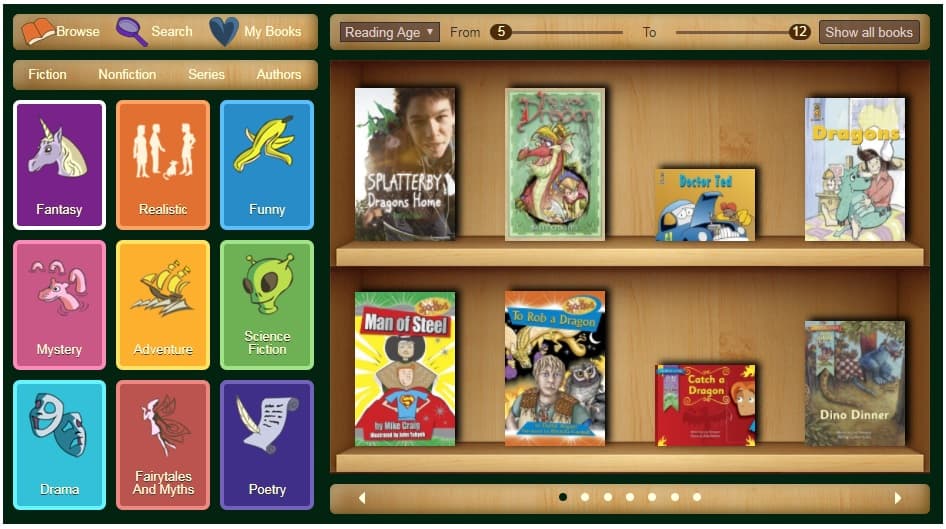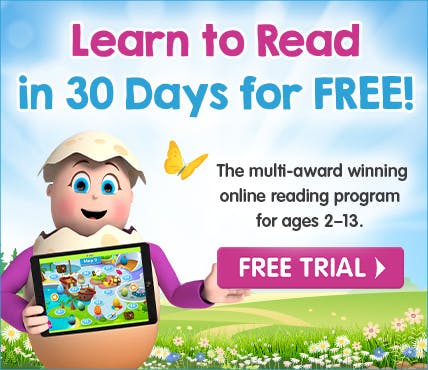


How to Teach a Child with Autism to Read

Structured reading programs like ABC Reading Eggs use visual accompaniments to help teach children with autism to read. Free trial
Learning to Read with Autism
Children with Autism Spectrum Disorder (ASD) can face distinct challenges in learning to read. ASD is a spectrum, so the range of challenges is different for every child. But for many young children with ASD, it affects the development of foundational language and social skills. This impacts reading readiness, comprehension skills, and a child's overall approach to learning.
This is why it's especially important to explicitly provide children with ASD the tools to help them become successful readers.
3 Ways to Spark an Interest in Reading for Children with Autism
One of the most important things you can do to help a child with autism to read is to promote an active interest in reading.
Here are three easy way to nurture your child's interest in reading:
1. Start early
While it's ideal for ALL children to develop an enthusiasm for learning to read, it's especially important for children with ASD. Reading and sharing books together can help not only reading, but also social skills. So start reading early!
Many children with ASD thrive on repetition and routine, so don't be afraid to read the same story again and again. Each time you read, you can build on pre‑reading skills by asking your child to turn the pages, point to different characters or retell the story.
ABC Reading Eggs has an online library of over 3500 books to help you choose the right book for your child's ability and interests. Start your free trial here.
Try the award‑winning reading program for FREE!
ABC Reading Eggs is the multi‑award winning online reading program that helps children of all abilities learn how to read. The program can be a great way to support children with autism, and features visually engaging lessons and activities that progress at your child's learning pace. Start your 30-day free trial today!
2. Follow interests
Make sure to choose books about topics your child enjoys. If your child loves trucks or sharks, incorporate those aspects of his or her life into the reading process.

The ABC Reading Eggspress library can be searched by topic and genre to help you find books that meet your child's interests. Best of all, the library is visually intuitive making it easily navigated by younger children. All books under level 20 have read‑aloud audio which means that your child can be read to anywhere, anytime. Free trial
3. Ask the right questions
Ask comprehension questions suited to your child's strengths. Children with ASD are usually more capable of answering literal comprehension questions rather than inferential, so focus on Who, What, Where and When questions after reading.
To help you, every book in the ABC Reading Eggs program includes some literal questions at the end to build comprehension skills.
4 Tips to Help Teach an Autistic Child to Read
You've piqued an interest in reading and now you face the challenge of how to help your child with ASD learn to read.
Children with ASD don't always develop early literacy skills in the same order or along the same timeline as other children. Supporting their skills development requires structure and extra patience, but most importantly an acknowledgement of the incremental improvements, no matter how small.
Using direct instruction, repeating skills and strategies, and acknowledging achievement all help motivate children with ASD to learn to read.
Here are four helpful tips for teaching an autistic child to read:
1. Provide direct and explicit phonics instruction
Direct phonics instruction for reading requires explicitly teaching the 44 consonant and vowel phonemes in a logical sequenced curriculum.
For children with ASD, explicit teaching effectively breaks learning-to-read into manageable chunks.
Current best practice in pedagogical learn‑to‑read research supports short, phonics‑based instructional sessions. ABC Reading Eggs explicitly and systematically teaches letters and sounds to build letter recognition and alphabet knowledge. Each letter/sound correspondence is explicitly taught and every lesson can be regularly repeated.
By bringing together explicit, systematic teaching with interactive, engaging activities, ABC Reading Eggs is able to deliver a program that helps unlock reading for children.

ABC Reading Eggs features highly structured, systematic and sequential phonics lessons that support children of all abilities along their reading journey. Free trial
2. Give very clear instructions
All children get the best chance at success if they understand exactly what they need to do. For many children with ASD, having one step of verbal instruction at a time helps them to prioritise new information.
All instructions in ABC Reading Eggs are given in a succinct, explicit way to help children understand the activities. It breaks the task into short, manageable chunks. The clear instructions can be heard as many times as needed before beginning each activity in every lesson. Many activities repeat across lessons and this helps children become familiar with what they need to do, so that they can focus on learning new skills.
Try the award‑winning reading program for FREE!
ABC Reading Eggs is the multi‑award winning online reading program that helps children of all abilities learn how to read. The program can be a great way to support children with autism, and features visually engaging lessons and activities that progress at your child's learning pace. Start your 30-day free trial today!
3. Teach reading comprehension strategies
As mentioned earlier, children with ASD are often better at literal comprehension, requiring them explicitly taught inferential reading comprehension skills.
Reading strategies like self-monitoring and vocabulary instruction can all help learners with ASD understand the texts they read.
ABC Reading Eggspress (which follows on from ABC Reading Eggs) teaches inferential reading strategies in easy‑to‑follow lessons to give children—including those with ASD—the best chance at unlocking reading success.
4. Reward progress
It's important to acknowledge any improvement in your child's reading ability, no matter how small.
In each ABC Reading Eggs lesson, children complete a range of activities where their efforts are acknowledged and their progress rewarded. They are given immediate, constructive feedback as they move through each stage of the program. This helps children know they are making progress and feel motivated to continue.
5. Use pictures and flashcards
Many children with autism are visual learners and benefit when a whole word is accompanied by its picture. Remember to present the picture and the printed word on the same side of the card if using flashcards. This is a great way to build vocabulary.
6. 'Show' your child nouns and act out action words
When teaching your child nouns, allow them to hear you speak the word while you display the picture and printed word simultaneously. When teaching verbs, hold up a card with the action word (e.g. “wave”) and act out the verb by showing that action (e.g. waving while saying “wave”).
7. Put labels on objects and toys
Gather the objects and toys that your child regularly uses. Then write the first letter of its name on a card and tape it to the object. Each time your child asks to use or play with it, ask them what letter it starts with. Over time, move on to labelling each object with the entire word.
8. Create a distraction‑free zone
Read together in a quiet and sensory‑neutral space. It's best to choose a dimly lit room with little or no posters or artworks on the wall. Sit on the floor with your child and speak in a quiet voice. Avoid fidgeting or multi‑tasking while reading with your child, and don't forget to take frequent reading breaks to provide regular sensory stimulation.
9. Use clear and short phrases
Avoid varying your language too much or using different words when giving directions or instructions. Ensure phrases are clear and concise, for example, “Sarah, read your book with Mummy/Daddy” or “Read the first page of this book”.
10. Let your child read the same story again and again
Many children with autism enjoy and benefit from repetition, and by reading the same story again, you can help them pick up important language skills. Choose books that have a lot of repetition of phrases, such as nursery rhymes. Softly clap along to the rhythm together.
11. Enhance learning with technology
A study in the Journal of Autism and Development Disorders found that children with autism gain greater enjoyment from computer‑based instruction in reading. Choose phonics‑based programs like ABC Reading Eggs that include rich visuals and a self‑paced learning structure.
See how ABC Reading Eggs can help children with autism learn to read
We offer parents a free 30-day trial so they can see how ABC Reading Eggs works for their child.
Try the award‑winning reading program for FREE!
ABC Reading Eggs is the multi‑award winning online reading program that helps children of all abilities learn how to read. The program can be a great way to support children with autism, and features visually engaging lessons and activities that progress at your child's learning pace. Start your 30-day free trial today!
American Psychiatric Association (2017) What is autism spectrum disorder, as retrieved 12 October 2017 from https://www.psychiatry.org/patients-families/autism/what-is-autism-spectrum-disorder
Lanter, E. & Watson, L. (2008). Promoting literacy in students with ASD: The basics for the SLP. Language, Speech, and Hearing Services in Schools, 39, 33-43.
AU: National Inquiry into the Teaching of Literacy (2005) Teaching reading: Report and recommendations. Commonwealth of Australia: Australian Capital Territory.
UK: Rose, J. (2006) Independent review of the teaching of early reading. London: Department for Education and Skills, as retrieved 12 October 2017 from http://dera.ioe.ac.uk/5551/2/report.pdf
US: National Institute of Child Health and Human Development (2000) Report of the National Reading Panel. Teaching children to read: An evidence-based assessment of the scientific research literature on reading and its implications for reading instruction (NIH Publication No. 00-4769), U.S. Government Printing Office, Washington, D.C, as retrieved 12 October 2017 from www.nichd.nih.gov/publications/pubs/nrp/documents/report.pdf
Ganz J, Flores M. The effectiveness of direct instruction for teaching language to children with autism spectrum disorders: Identifying materials. Journal of Autism and Developmental Disorders. 2009(39)75–83. DOI: 10.1007/s10803-008-0602-6
Mahdavi, J. N. & Tensfeldt, L. (2013). Untangling reading comprehension strategy instruction: Assisting struggling readers in the primary grades. Preventing School Failure, 57 (2), 77–92.






